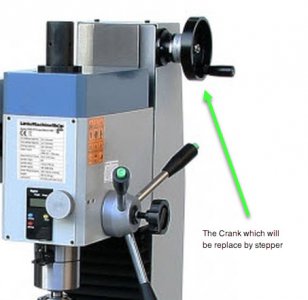I've scoured the net and have been immersed in all sorts of formulas! This is the result of my work, and hoping there is a good engineer/machinist/math head here that can confirm (or deny) my conclusions.
I want to build an Arduino controlled stepper system to raise and lower the mill head (Sieg SX2.7/LMS 5500). I know you can buy stuff - but "just wanna do this!"
The work follows: (excuse any lapses of terminology...)
A milling machine has a head that is raised and lowered by a leadscrew. The leadscrew pitch is .05" i.e it moves the head .05" per revolution of the crank. The crank is attached to the leadscrew through 2 bevel gears, so there is a bit of additional built in mechanical advantage.
Empirically I've found that it takes about 4 Lbs to move the crank up a turn or two. I'm using 5lb as the load
.05" = 1.27mm or .00127 meters
5 Lb = 2.3 Kg
Force = m*a - so the force of gravity on this mass is 2.3 Kg* 9.8 m/s or about 23 Newtons.
Allow 1 second for 1 turn of the screw = 1.27mm/second
I'd like to raise the head at 10 turns/second which = 12.7mm/second.
The additional lifting force (friction and other losses aside) will be 2.3 Kg * 12.7 = 29 Newtons
23N+29N = 52 Newtons total - I'll use 60N
The stepper will have a 36 groove timing pulley with PD of 35mm or r of .0175 meters
Torque at motor shaft will be 60N * .0175 = 1.05 N/m
If I attach a 72 groove timing pulley with a PD of 69 mm I should get a 2X torque multiplication
which will give 2.1 N/m at the drive shaft.
Power needed will be 60N * .0127 m/s = .76 watts
So - Minimum requirements:
2 watt 24 VDC power supply
Any steper motor holding torque of better than 1.05 N/m.
I want to build an Arduino controlled stepper system to raise and lower the mill head (Sieg SX2.7/LMS 5500). I know you can buy stuff - but "just wanna do this!"
The work follows: (excuse any lapses of terminology...)
A milling machine has a head that is raised and lowered by a leadscrew. The leadscrew pitch is .05" i.e it moves the head .05" per revolution of the crank. The crank is attached to the leadscrew through 2 bevel gears, so there is a bit of additional built in mechanical advantage.
Empirically I've found that it takes about 4 Lbs to move the crank up a turn or two. I'm using 5lb as the load
.05" = 1.27mm or .00127 meters
5 Lb = 2.3 Kg
Force = m*a - so the force of gravity on this mass is 2.3 Kg* 9.8 m/s or about 23 Newtons.
Allow 1 second for 1 turn of the screw = 1.27mm/second
I'd like to raise the head at 10 turns/second which = 12.7mm/second.
The additional lifting force (friction and other losses aside) will be 2.3 Kg * 12.7 = 29 Newtons
23N+29N = 52 Newtons total - I'll use 60N
The stepper will have a 36 groove timing pulley with PD of 35mm or r of .0175 meters
Torque at motor shaft will be 60N * .0175 = 1.05 N/m
If I attach a 72 groove timing pulley with a PD of 69 mm I should get a 2X torque multiplication
which will give 2.1 N/m at the drive shaft.
Power needed will be 60N * .0127 m/s = .76 watts
So - Minimum requirements:
2 watt 24 VDC power supply
Any steper motor holding torque of better than 1.05 N/m.



